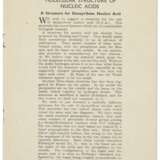ID 627528
Lot 38 | The discovery of the structure of DNA
Estimate value
$ 10 000 – 15 000
The first announcement of the discovery of the structure of DNA; Leonard Hamilton's copy. This 25 April 1953 Nature paper is the single most important work in the history of the life sciences. With its memorable opening: "We wish to suggest a structure for the salt of deoxrybose nucleic acid (D.N.A.). This structure has novel features which are of considerable biological interest," it correctly interpreted the structure of DNA as a double helix. This discovery explained how heredity messages could be encoded in a crystalline structure that was stable and yet allowed for both replication and mutation. Crick and Watson published their paper as a complete work—they did not reveal their work to the scientific community in stages—and thus its impact was all the greater. It revolutionised biochemistry and the other life sciences, and profoundly affected the study of molecular biology. This copy belonged to Dr. Leonard Hamilton of Sloan-Kettering Institute of New York. Hamilton was a Cambridge-educated biochemist, just a few years younger than Francis Crick and Maurice Wilkins, with whom he was close friends. It was Hamilton who supplied the DNA specimens for Wilkins' lab to photograph. Wilkins wrote an excited letter to Hamilton on 20 March 1953, a month before the publication of this article, calling his specimens, "bloody good stuff" that gave "crystalline pictures!"
Octavo (210 x 140mm). 6 conjugate leaves and one half-leaf 7, 4 text illustrations including the double helix. Comprising "A Structure for Deoxyribose Nucleic Acid" by Watson and Crick, "Molecular Structure of Deoxypentose Nucleic Acids" by Maurice Wilkins, Alec Stokes and Herbert Wilson, and "Molecular Configuration in Sodium Thymonucleate" by Rosalind Franklin and Ray Gosling. Self wrapper, stapled with the last leaf tipped at left edge onto preceding page as issued (rubbing around staples). Provenance: Leonard D. Hamilton, 1921-2019 (ownership stamp to front page).
The papers of Leonard Hamilton, including his very extensive correspondence with Maurice Wilkins, and correspondence with Francis Crick and others, are currently being represented for private sale by Christie's. Please contact the Books Department sale coordinator for further details.
| Artist: | William Shakespeare (1564 - 1616) |
|---|---|
| Applied technique: | Pencil |
| Artist: | William Shakespeare (1564 - 1616) |
|---|---|
| Applied technique: | Pencil |
| Address of auction |
CHRISTIE'S 8 King Street, St. James's SW1Y 6QT London United Kingdom | |
|---|---|---|
| Preview |
| |
| Phone | +44 (0)20 7839 9060 | |
| Buyer Premium | see on Website | |
| Conditions of purchase | Conditions of purchase |












